Assessment Tool Development for Competency-Based Assessment
VerifiedAdded on 2021/09/12
|5
|985
|313
Homework Assignment
AI Summary
This document provides a comprehensive solution to an assessment tool development assignment. It begins by matching training package components to their application in developing assessment tools, covering competency standards, qualifications frameworks, and assessment guidelines. The solution then explores the relationship between assessment context and tools, followed by matching assessment methods like portfolio, questioning, and direct observation to their descriptions and scenarios. It includes methods for trialing and reviewing assessment tools, and explains the principles of reasonable adjustment. The assignment also details the four principles of assessment (reliability, fairness, flexibility, and validity) and the four rules of evidence (valid, sufficient, authentic, and current) and explains how each is applied in the validation of competency-based assessments. This document serves as a valuable resource for understanding and implementing effective assessment strategies.
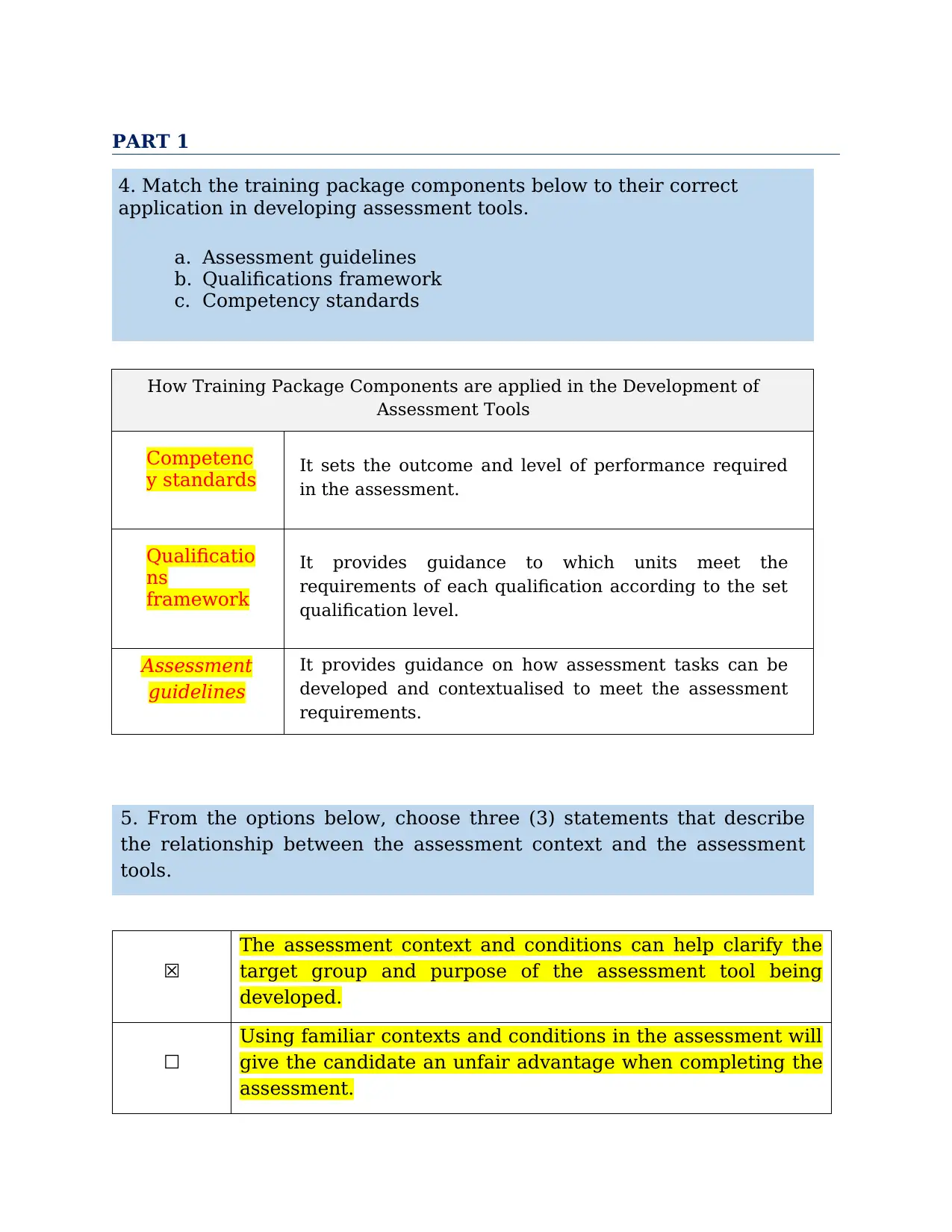
PART 1
4. Match the training package components below to their correct
application in developing assessment tools.
a. Assessment guidelines
b. Qualifications framework
c. Competency standards
How Training Package Components are applied in the Development of
Assessment Tools
Competenc
y standards It sets the outcome and level of performance required
in the assessment.
Qualificatio
ns
framework
It provides guidance to which units meet the
requirements of each qualification according to the set
qualification level.
Assessment
guidelines
It provides guidance on how assessment tasks can be
developed and contextualised to meet the assessment
requirements.
5. From the options below, choose three (3) statements that describe
the relationship between the assessment context and the assessment
tools.
☒
The assessment context and conditions can help clarify the
target group and purpose of the assessment tool being
developed.
☐
Using familiar contexts and conditions in the assessment will
give the candidate an unfair advantage when completing the
assessment.
4. Match the training package components below to their correct
application in developing assessment tools.
a. Assessment guidelines
b. Qualifications framework
c. Competency standards
How Training Package Components are applied in the Development of
Assessment Tools
Competenc
y standards It sets the outcome and level of performance required
in the assessment.
Qualificatio
ns
framework
It provides guidance to which units meet the
requirements of each qualification according to the set
qualification level.
Assessment
guidelines
It provides guidance on how assessment tasks can be
developed and contextualised to meet the assessment
requirements.
5. From the options below, choose three (3) statements that describe
the relationship between the assessment context and the assessment
tools.
☒
The assessment context and conditions can help clarify the
target group and purpose of the assessment tool being
developed.
☐
Using familiar contexts and conditions in the assessment will
give the candidate an unfair advantage when completing the
assessment.
Paraphrase This Document
Need a fresh take? Get an instant paraphrase of this document with our AI Paraphraser
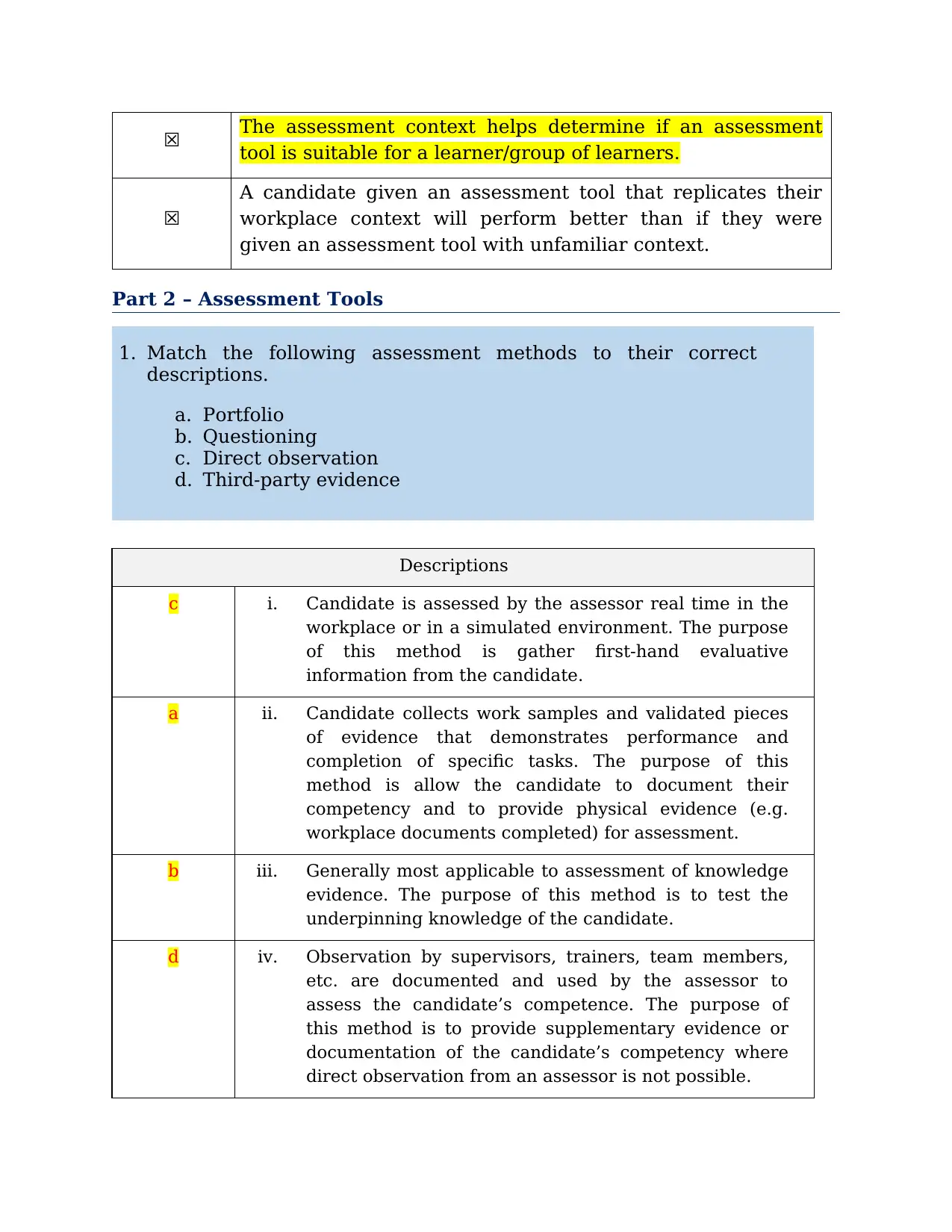
☒ The assessment context helps determine if an assessment
tool is suitable for a learner/group of learners.
☒
A candidate given an assessment tool that replicates their
workplace context will perform better than if they were
given an assessment tool with unfamiliar context.
Part 2 – Assessment Tools
1. Match the following assessment methods to their correct
descriptions.
a. Portfolio
b. Questioning
c. Direct observation
d. Third-party evidence
Descriptions
c i. Candidate is assessed by the assessor real time in the
workplace or in a simulated environment. The purpose
of this method is gather first-hand evaluative
information from the candidate.
a ii. Candidate collects work samples and validated pieces
of evidence that demonstrates performance and
completion of specific tasks. The purpose of this
method is allow the candidate to document their
competency and to provide physical evidence (e.g.
workplace documents completed) for assessment.
b iii. Generally most applicable to assessment of knowledge
evidence. The purpose of this method is to test the
underpinning knowledge of the candidate.
d iv. Observation by supervisors, trainers, team members,
etc. are documented and used by the assessor to
assess the candidate’s competence. The purpose of
this method is to provide supplementary evidence or
documentation of the candidate’s competency where
direct observation from an assessor is not possible.
tool is suitable for a learner/group of learners.
☒
A candidate given an assessment tool that replicates their
workplace context will perform better than if they were
given an assessment tool with unfamiliar context.
Part 2 – Assessment Tools
1. Match the following assessment methods to their correct
descriptions.
a. Portfolio
b. Questioning
c. Direct observation
d. Third-party evidence
Descriptions
c i. Candidate is assessed by the assessor real time in the
workplace or in a simulated environment. The purpose
of this method is gather first-hand evaluative
information from the candidate.
a ii. Candidate collects work samples and validated pieces
of evidence that demonstrates performance and
completion of specific tasks. The purpose of this
method is allow the candidate to document their
competency and to provide physical evidence (e.g.
workplace documents completed) for assessment.
b iii. Generally most applicable to assessment of knowledge
evidence. The purpose of this method is to test the
underpinning knowledge of the candidate.
d iv. Observation by supervisors, trainers, team members,
etc. are documented and used by the assessor to
assess the candidate’s competence. The purpose of
this method is to provide supplementary evidence or
documentation of the candidate’s competency where
direct observation from an assessor is not possible.
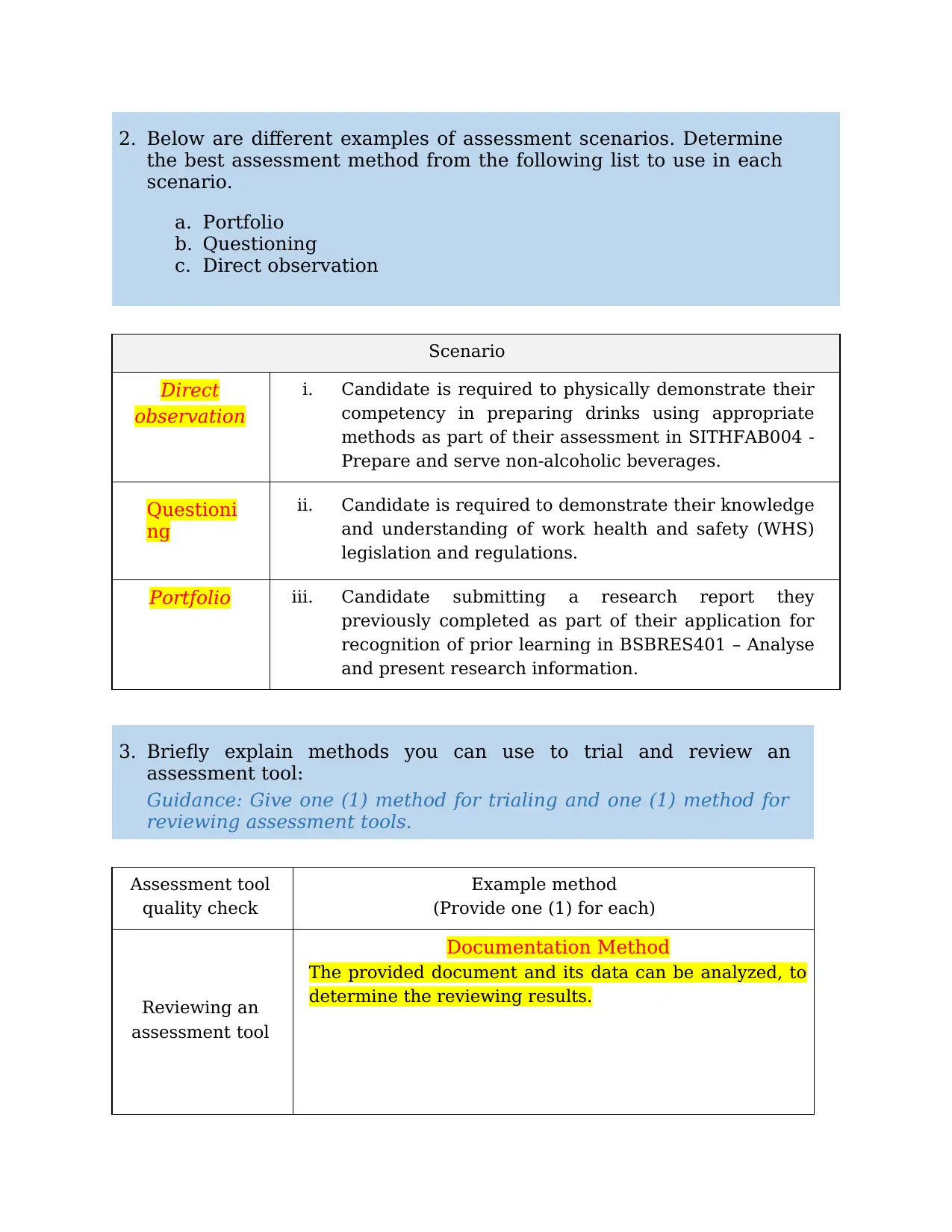
2. Below are different examples of assessment scenarios. Determine
the best assessment method from the following list to use in each
scenario.
a. Portfolio
b. Questioning
c. Direct observation
Scenario
Direct
observation
i. Candidate is required to physically demonstrate their
competency in preparing drinks using appropriate
methods as part of their assessment in SITHFAB004 -
Prepare and serve non-alcoholic beverages.
Questioni
ng
ii. Candidate is required to demonstrate their knowledge
and understanding of work health and safety (WHS)
legislation and regulations.
Portfolio iii. Candidate submitting a research report they
previously completed as part of their application for
recognition of prior learning in BSBRES401 – Analyse
and present research information.
3. Briefly explain methods you can use to trial and review an
assessment tool:
Guidance: Give one (1) method for trialing and one (1) method for
reviewing assessment tools.
Assessment tool
quality check
Example method
(Provide one (1) for each)
Reviewing an
assessment tool
Documentation Method
The provided document and its data can be analyzed, to
determine the reviewing results.
the best assessment method from the following list to use in each
scenario.
a. Portfolio
b. Questioning
c. Direct observation
Scenario
Direct
observation
i. Candidate is required to physically demonstrate their
competency in preparing drinks using appropriate
methods as part of their assessment in SITHFAB004 -
Prepare and serve non-alcoholic beverages.
Questioni
ng
ii. Candidate is required to demonstrate their knowledge
and understanding of work health and safety (WHS)
legislation and regulations.
Portfolio iii. Candidate submitting a research report they
previously completed as part of their application for
recognition of prior learning in BSBRES401 – Analyse
and present research information.
3. Briefly explain methods you can use to trial and review an
assessment tool:
Guidance: Give one (1) method for trialing and one (1) method for
reviewing assessment tools.
Assessment tool
quality check
Example method
(Provide one (1) for each)
Reviewing an
assessment tool
Documentation Method
The provided document and its data can be analyzed, to
determine the reviewing results.
⊘ This is a preview!⊘
Do you want full access?
Subscribe today to unlock all pages.

Trusted by 1+ million students worldwide
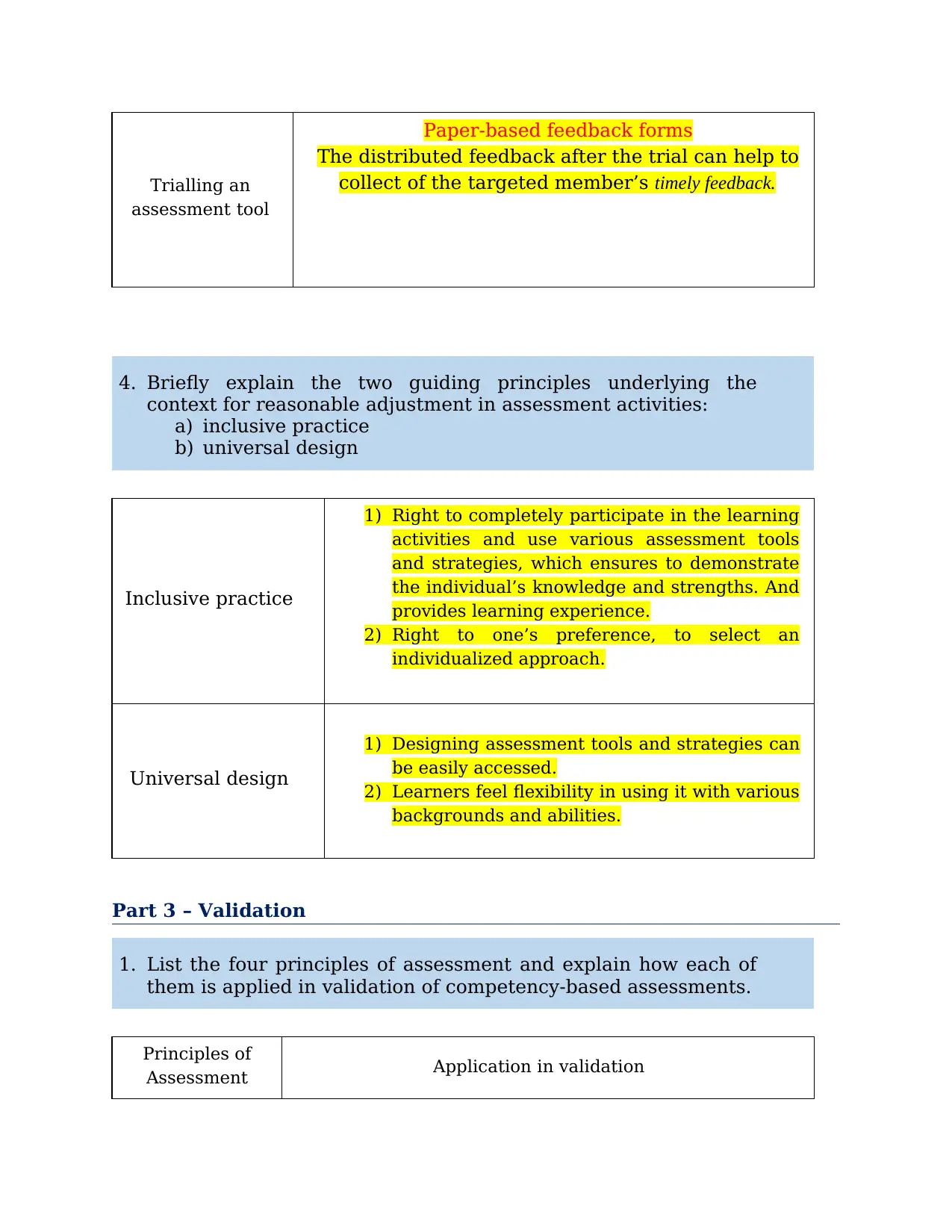
Trialling an
assessment tool
Paper-based feedback forms
The distributed feedback after the trial can help to
collect of the targeted member’s timely feedback.
4. Briefly explain the two guiding principles underlying the
context for reasonable adjustment in assessment activities:
a) inclusive practice
b) universal design
Inclusive practice
1) Right to completely participate in the learning
activities and use various assessment tools
and strategies, which ensures to demonstrate
the individual’s knowledge and strengths. And
provides learning experience.
2) Right to one’s preference, to select an
individualized approach.
Universal design
1) Designing assessment tools and strategies can
be easily accessed.
2) Learners feel flexibility in using it with various
backgrounds and abilities.
Part 3 – Validation
1. List the four principles of assessment and explain how each of
them is applied in validation of competency-based assessments.
Principles of
Assessment Application in validation
assessment tool
Paper-based feedback forms
The distributed feedback after the trial can help to
collect of the targeted member’s timely feedback.
4. Briefly explain the two guiding principles underlying the
context for reasonable adjustment in assessment activities:
a) inclusive practice
b) universal design
Inclusive practice
1) Right to completely participate in the learning
activities and use various assessment tools
and strategies, which ensures to demonstrate
the individual’s knowledge and strengths. And
provides learning experience.
2) Right to one’s preference, to select an
individualized approach.
Universal design
1) Designing assessment tools and strategies can
be easily accessed.
2) Learners feel flexibility in using it with various
backgrounds and abilities.
Part 3 – Validation
1. List the four principles of assessment and explain how each of
them is applied in validation of competency-based assessments.
Principles of
Assessment Application in validation
Paraphrase This Document
Need a fresh take? Get an instant paraphrase of this document with our AI Paraphraser
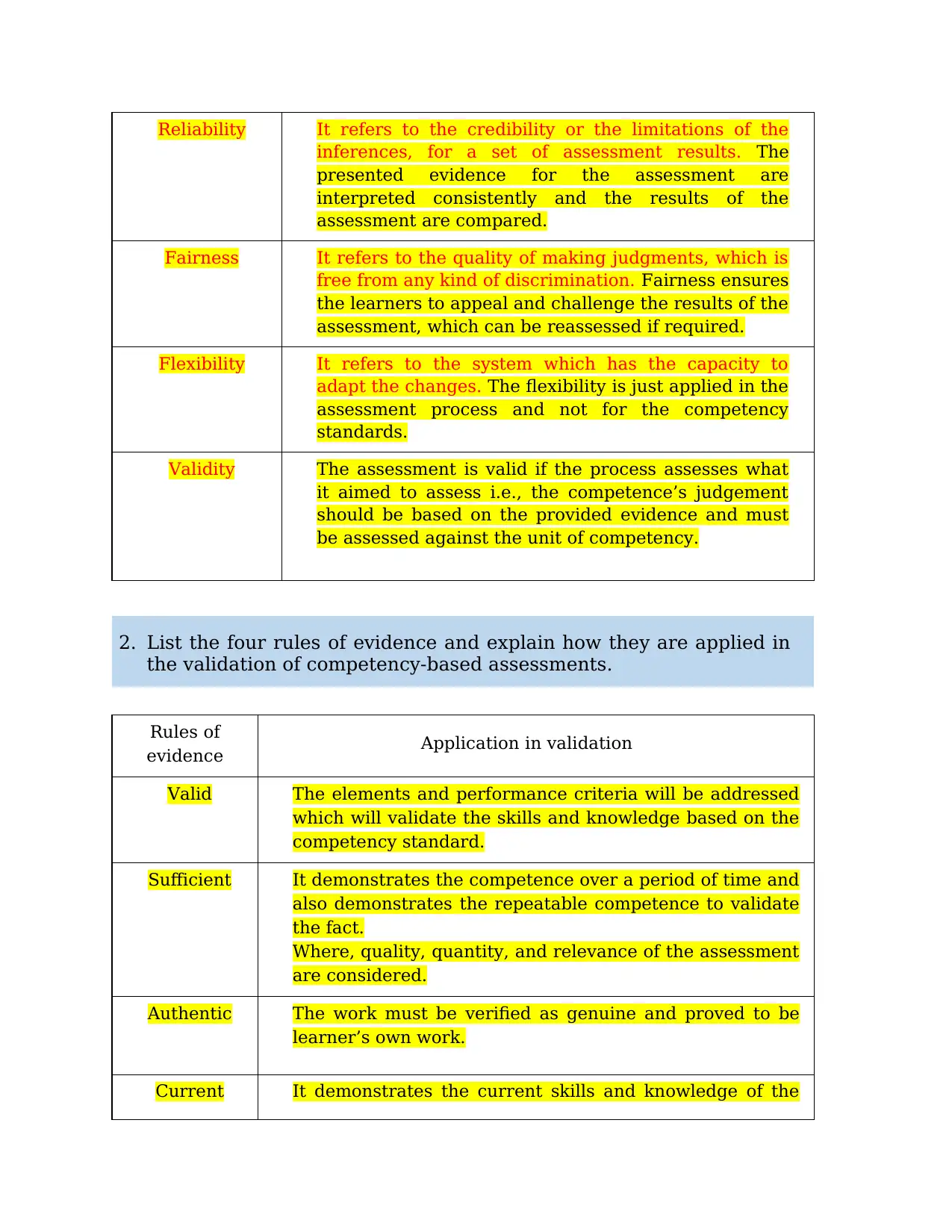
Reliability It refers to the credibility or the limitations of the
inferences, for a set of assessment results. The
presented evidence for the assessment are
interpreted consistently and the results of the
assessment are compared.
Fairness It refers to the quality of making judgments, which is
free from any kind of discrimination. Fairness ensures
the learners to appeal and challenge the results of the
assessment, which can be reassessed if required.
Flexibility It refers to the system which has the capacity to
adapt the changes. The flexibility is just applied in the
assessment process and not for the competency
standards.
Validity The assessment is valid if the process assesses what
it aimed to assess i.e., the competence’s judgement
should be based on the provided evidence and must
be assessed against the unit of competency.
2. List the four rules of evidence and explain how they are applied in
the validation of competency-based assessments.
Rules of
evidence Application in validation
Valid The elements and performance criteria will be addressed
which will validate the skills and knowledge based on the
competency standard.
Sufficient It demonstrates the competence over a period of time and
also demonstrates the repeatable competence to validate
the fact.
Where, quality, quantity, and relevance of the assessment
are considered.
Authentic The work must be verified as genuine and proved to be
learner’s own work.
Current It demonstrates the current skills and knowledge of the
inferences, for a set of assessment results. The
presented evidence for the assessment are
interpreted consistently and the results of the
assessment are compared.
Fairness It refers to the quality of making judgments, which is
free from any kind of discrimination. Fairness ensures
the learners to appeal and challenge the results of the
assessment, which can be reassessed if required.
Flexibility It refers to the system which has the capacity to
adapt the changes. The flexibility is just applied in the
assessment process and not for the competency
standards.
Validity The assessment is valid if the process assesses what
it aimed to assess i.e., the competence’s judgement
should be based on the provided evidence and must
be assessed against the unit of competency.
2. List the four rules of evidence and explain how they are applied in
the validation of competency-based assessments.
Rules of
evidence Application in validation
Valid The elements and performance criteria will be addressed
which will validate the skills and knowledge based on the
competency standard.
Sufficient It demonstrates the competence over a period of time and
also demonstrates the repeatable competence to validate
the fact.
Where, quality, quantity, and relevance of the assessment
are considered.
Authentic The work must be verified as genuine and proved to be
learner’s own work.
Current It demonstrates the current skills and knowledge of the
1 out of 5
Related Documents
Your All-in-One AI-Powered Toolkit for Academic Success.
+13062052269
info@desklib.com
Available 24*7 on WhatsApp / Email
![[object Object]](/_next/static/media/star-bottom.7253800d.svg)
Unlock your academic potential
Copyright © 2020–2025 A2Z Services. All Rights Reserved. Developed and managed by ZUCOL.





